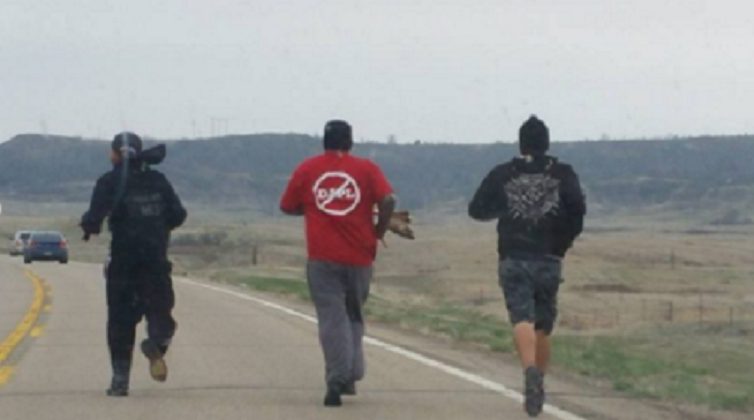
by Deep Green Resistance News Service | May 2, 2016 | Protests & Symbolic Acts
Omaha, NE – In solidarity with the ongoing fight against the Dakota Access pipeline, a group of Native and Non-native youth have organized a 500-mile spiritual relay run from Cannonball, ND to the district office of the United States Army Corps of Engineers (USACE) in Omaha, NE. The run is titled “Run For Your Life: No DAPL.” It departed the Cannonball community on April 24th, 2016 and plans to arrive in Omaha on May 3rd, 2016. The intention of the run is to deliver an unified statement to the USACE in resistance to the oil pipeline that proposed to cross beneath sacred water needed for life. The runners will will also turn over a petition calling for a full Environmental Impact Statement (EIS) to be conducted on the Bakken pipeline.
The running group is currently in Lake Andes, SD and plans for one day of rest, departing for Santee, NE on Thursday, April 28th.The participating runners are comprised of concerned citizens from across North Dakota, South Dakota, Nebraska and Iowa.
For the past several months, Native and non-Native peoples in the Midwest have been battling the construction of the Dakota Access/Bakken pipeline, a project that will go from North Dakota into South Dakota, Iowa and southern Illinois. If constructed, this large-scale pipeline will cross the 12,000 year-old Missouri River, one of the largest water resources in the United States that supports millions of people with drinking and irrigation water. The U.S. Army Corps of Engineers has stated that they will make the final decision on Dakota Access, LLC’s final permit needed to construct the Dakota Access/Bakken Pipeline no later than May 6th, 2016 .
Dakota Access Pipeline (DAPL), owned by Energy Transfer Partners, L.P., is proposed to transport 450,000 barrels per day of Bakken crude oil from the lands of North Dakota to Patoka, Illinois. Dakota Access Pipeline is proposed to cross under the Missouri River twice, and poses as a threat to the sacred waters that the entire breadbasket of America depends on. The construction of Dakota Access will threaten everything from farming and drinking water to entire ecosystems, wildlife and food sources surrounding the Missouri.
The group asks that “Everyone stand with us against this threat to our health, our culture, and our sovereignty. We ask that everyone who lives on or near the Missouri River and its tributaries, everyone who farms or ranches in the local area, and everyone who cares about clean air and clean drinking water stand with us against the Dakota Access Pipeline!”
Dallas Goldtooth, Organizer with Indigenous Environmental Network, said: “We can not accept the risks an oil spill will cause upon the heartland of America. We cannot accept the trespassing across Oceti Sakowin lands by Big Oil. We cannot accept locking ourselves into more fossil fuels when Mother Earth demands us to leave fossil fuels in the ground. This Dakota Access pipeline is all risk, no reward. Simple as that.”
Follow the group’s Facebook page for run updates, and sign and share the group’s petition.
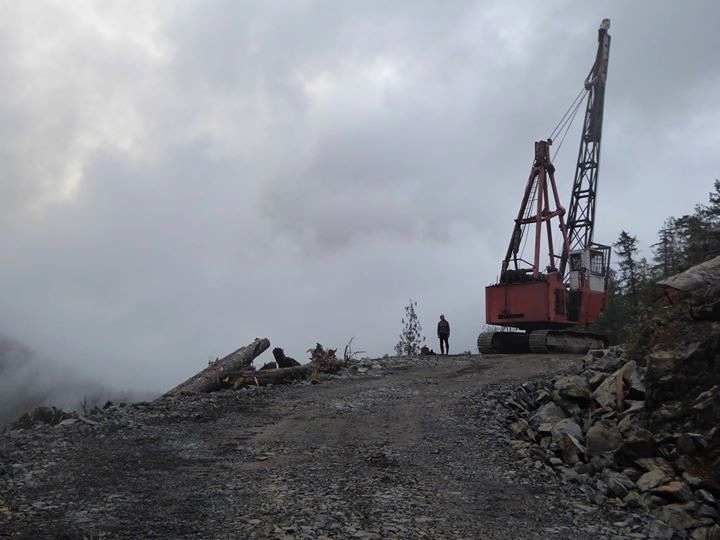
by Deep Green Resistance News Service | Apr 27, 2016 | Biodiversity & Habitat Destruction, Strategy & Analysis
By Zoe Blunt / WildCoast.ca
“I’m in love. With salmon, with trees outside my window, with baby lampreys living in sandy streambottoms, with slender salamanders crawling through the duff. And if you love, you act to defend your beloved.” — Derrick Jensen
Pacific Coast people have always defended the places we love. Most of British Columbia is unceded indigenous land; native peoples have never abandoned, sold, or traded their land away. Many fought fiercely against the power of the British Empire. Cannonballs are sometimes still found embedded in centuries-old trees along the shore – leftovers from the gunboats that tried to suppress indigenous uprisings in the late 1800s.

Nuu-chah-nulth war canoes (Edward Curtis, BC Historical Society)
A century later, descendants of the settlers have joined forces to battle corporate raiders. In the 1980s and 1990s, a groundswell of eco-organizing brought thousands of people together to stop clearcut logging in the cathedral forests of Vancouver Island’s Pacific coast, where timber companies were busy converting ten-thousand-year-old ecosystems into barren stumpfields and pulp for paper.
During those years, police arrested hundreds in Clayoquot Sound and the Walbran Valley at mass civil disobedience protests. Young and old alike sat in the middle of the logging roads and linked arms. The resistance went far beyond the peaceful and symbolic: unknown individuals spiked thousands of trees to make the timber dangerous to sawmills. Shadowy figures burned logging bridges and vandalized equipment. The skirmishes went on for over a decade.

Clayoquot Sound, 1993
We won a few battles. Several coastal valleys are protected as parks. But many of them have been logged. And now the logging companies are coming back for the valleys that remain unprotected.
One of the worst corporate offenders is Teal Jones, the company currently bulldozing the majestic Walbran Valley, two hours west of Victoria, BC. They are laying waste to a vibrant rainforest for short-term profit, without the consent of the Pacheedaht First Nation, the Qwa-ba-diwa people, or anyone else outside of government and industry. Teal Jones does not even own the land; it was taken from indigenous people in the name of the BC government sixty years ago.

Pacheedaht territory, Vancouver Island BC
This year, the elected leadership of the Pacheedaht First Nation threw its support behind building a longhouse in the contested valley, on the land that has sustained them for countless generations. At the same time, locals are pushing back against the logging by occupying roads and logging sites. This in spite of the company’s court order telling police to arrest anyone who blocks their work. Forest defenders are regrouping, but the destruction continues.
Women for the Walbran and Forest Action Network are ramping up to break the deadlock. We’re hosting direct action trainings to share skills and develop strategies for defending ecosystems. The agenda includes tactics like non-violent civil disobedience, occupying tree-tops, and backcountry stealth. We’ll have info on legal rights, indigenous solidarity, and more.

Tree-sit occupation, Langford BC. (Photo: Ingmar Lee)
Our adversary, Teal Jones, is a relatively small company. Its owners are relying on the police to protect their “right” to strip public forests on Pacheedaht traditional territory. Profit margins are slim, and lawyers are expensive. The forest defenders are poor, but we have community support and a wide array of strategies for beating Teal Jones at its own game. Every tool in the box: we can launch a mass civil disobedience campaign, carry out hit-and-run raids on costly machines, coordinate a knockout legal strategy, or deliver the tried-and-true “death by a thousand cuts” with a combination of tactics.
However it plays out, Teal Jones is on borrowed time in the Walbran. But that’s cold comfort when the machines are mowing down thousand-year-old forests like grass.

Photo: Walbran Central
The forest defenders do have certain advantages. On the practical side, we’re investing in the gear and training that will provide the leverage to win. We have a legal defense fund that’s both a war chest for litigation and a safety net for those who risk their freedom on the front lines. But our best defense is the thousands of people who love this land like life itself. Many live nearby and visit every chance they get, others came once and fell in love, and untold numbers have yet to see the Walbran’s wildlife firsthand, but they hold it in their hearts.

Photo: Walbran Central
Those who love the land are a community. We are the organizers, sponsors, and volunteers who drive this movement forward. Everyone who shares these values can be a part of it; no contribution is too small. We’re going all-out to defend the forests, rivers, bears, cougars, otters, and eagles of the Walbran Valley. They sustain us and we give back by fighting to protect them.

Walbran River, the heart of the Walbran Valley, spring 2016. (Photo: Walbran Central)
Remember: Forest Defenders Are Heroes!
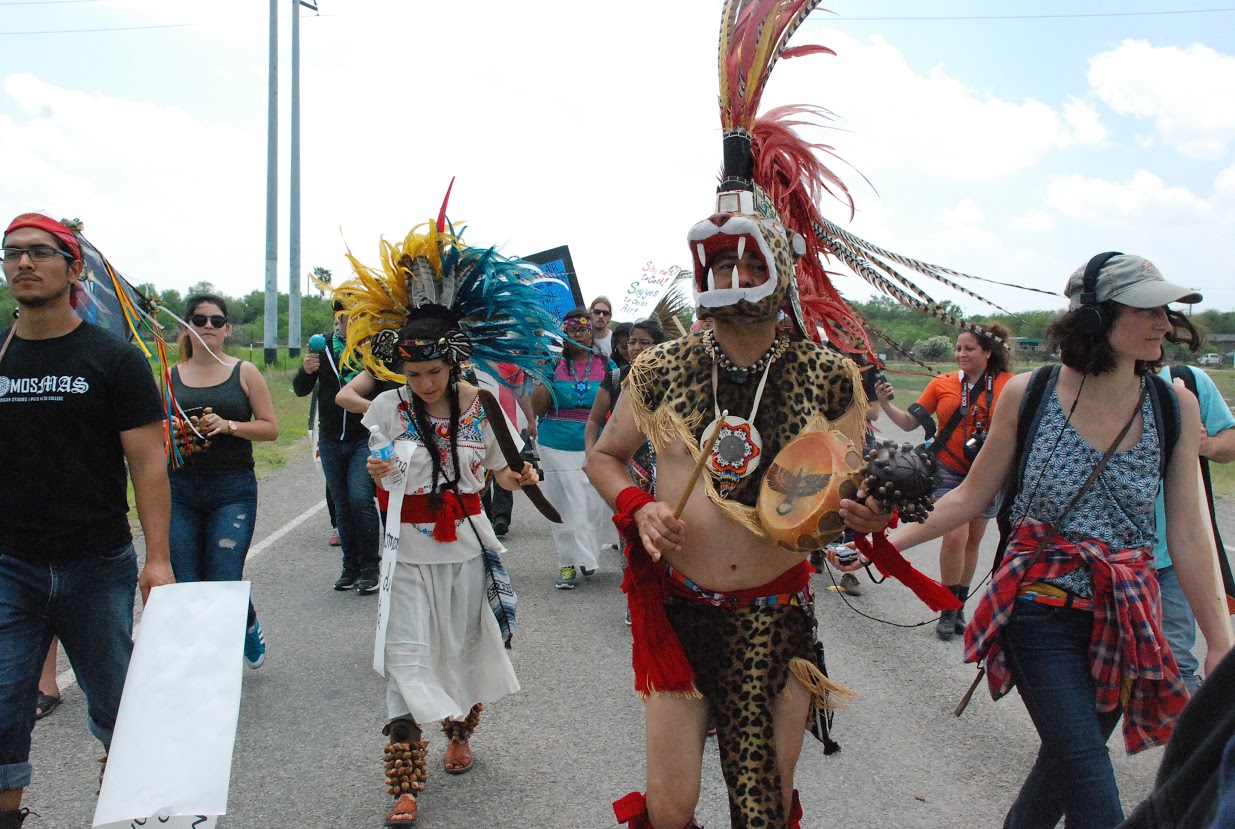
by Deep Green Resistance News Service | Apr 24, 2016 | Mining & Drilling, Protests & Symbolic Acts
Via Censored News
EAGLE PASS, Tex. — Native American Groups gathered today for a historic rally and march to protest the open-pit coal strip mine in Eagle Pass, Tex. The protesters called on the U.S. Army Corps of Engineers to rescind the mine’s permit, halt expansion and protect the land from further destruction. The project, owned by Dos Republicas Coal Partnership, mines lignite coal, which is transported by train from Maverick County across the border to be burned in a Mexican coal-fired power plant. The mine began operating several months ago, despite local opposition, and is harming the ancestral homelands of many Native groups and damaging sacred lands and more than 100 archaeological sites.
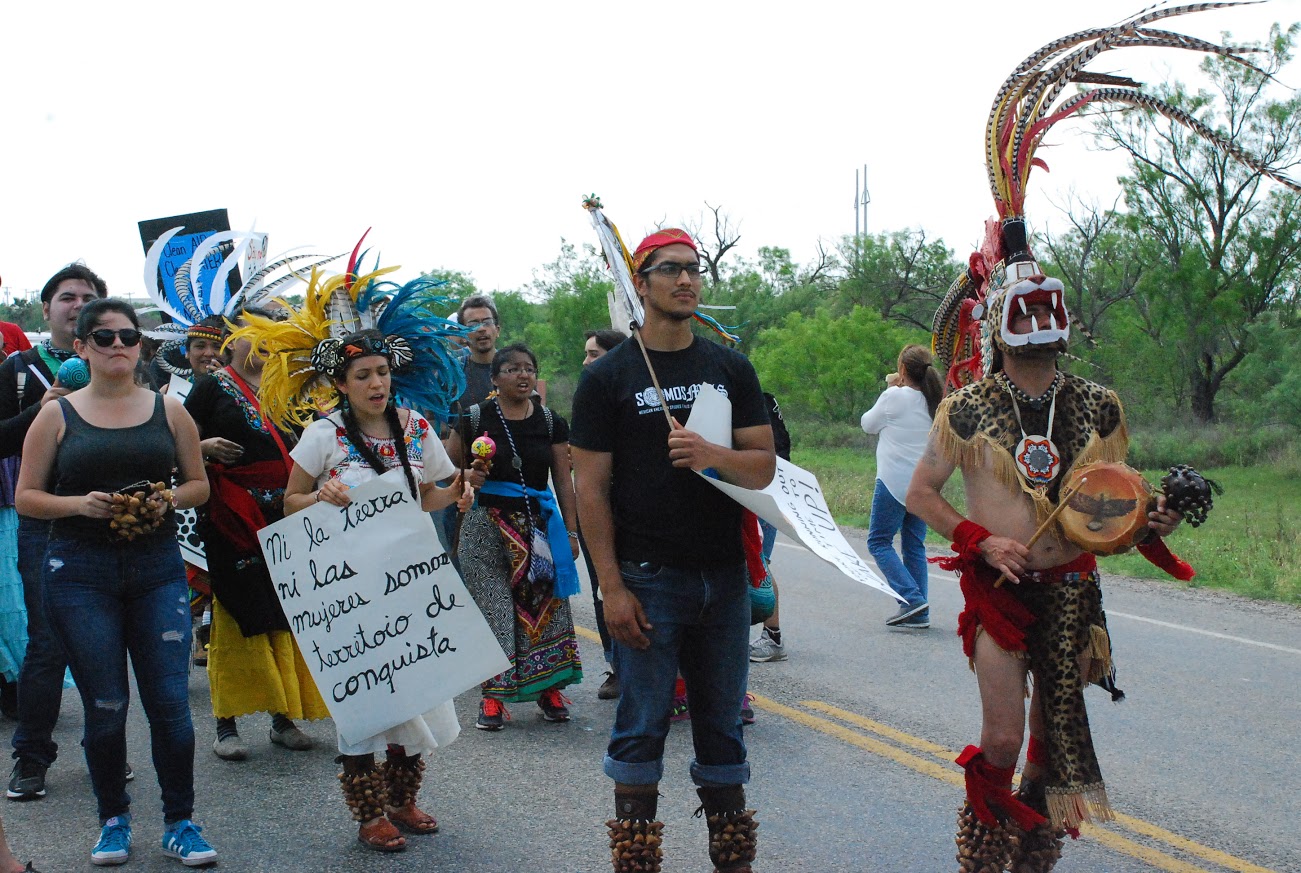
“This mine has already caused irreparable damage, destroying multiple burial sites and erasing our cultural heritage in the process,” said Maria Torres, Tribal Chairwoman of the Pacuache Clan of Texas. “This land is our patrimonial heritage, and it holds the story of our ancient aboriginal people—how we lived and how we died. When we lose access to our land and to the ancient wildlife of the area, from the jaguarundi and ocelot to crucial plant life, we lose part of our heritage and our connection with Mother Earth.”
Many Native groups say they were not properly consulted by Federal agencies as required prior to granting the permits necessary for the coal mine to open. More than eight thousand Eagle Pass residents and allies signed a petition in opposition to the Dos Republicas mine before its opening.

“This project is the worst example of environmental injustice I’ve seen,” said Dr. Jonathan Hook, former Director of Environmental Justice and Tribal Affairs for the EPA, Cherokee Nation citizen and Maverick County resident. “Everything about it is wrong. Given the incomplete processes and potential damage to one of the most vulnerable communities in the country, the Dos Republicas mine should have been stopped before it even started.”
Representatives from the Lipan Apache Band of Texas, Pacuache Band Coahuiltecan Nation, Carrizo-Comecrudo Tribe of Texas, and American Indian Movement of Central Texas were present at the Saturday event, which included Native regalia, drumming, and other cultural expressions along with large banners, signs, and puppets.
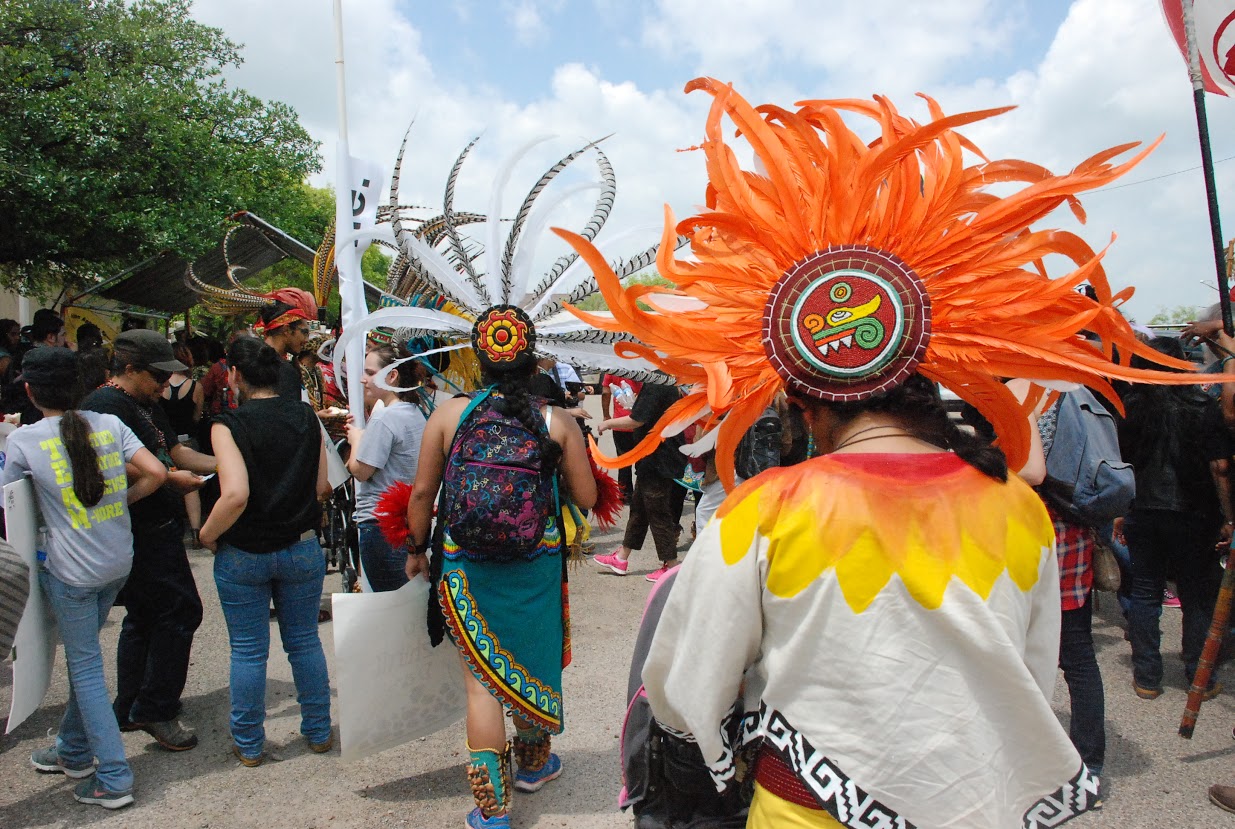
“Native leaders, tribal members and allies from across the country are uniting here today, and they join thousands from the area who are standing up against this disastrous project,” said Dr. Tane Ward, and Native and decolonial organizer working with the Sierra Club. “It’s unclear why the state of Texas has been so supportive of the controversial mining project. Not only does it harm culturally rich and historic land, the Dos Republicas mine threatens the safety and livelihood of those who live nearby all so the coal can be shipped to Mexico and burned in coal plants. It’s time for this dangerous project to be stopped, once and for all.”
Read more about the Dos Replicas Mine at the Sierra Club Lone Star Chapter’s website.

by Deep Green Resistance News Service | Apr 16, 2016 | Climate Change, Education, Strategy & Analysis
Stopping Coal and Oil Trains Through
Civil Disobedience: Stories of Courage
on the Front Lines of Climate Change
Saturday, April 23rd at 7pm
Spokane Community College – Lair Student Center
Free admission
Featured speakers:
Event host – Direct Action Spokane

by Deep Green Resistance News Service | Apr 10, 2016 | Indigenous Autonomy, Obstruction & Occupation
Featured image: The spirit riders at Standing Rock show support for keeping the Missouri River waters clean. Image by Steve Sitting Bear.
By Chelsey Luger / Indian Country Today Media Network
In the coming weeks or maybe even days, the U.S. Army Corps of Engineers will issue a decision as to whether or not they will allow the Dakota Access Pipeline, also known as the Bakken Pipeline, to be constructed.
Until then, citizens and allies of the Oceti Sakowin (Seven Council Fires of the Great Sioux Nation) will continue to protest the pipeline, urging stakeholders to recognize the devastation that would ensue should the pipeline be built.
“The DAPL poses a threat to our people, cultural and historically significant areas,” said Paula Antonie, Chair of Shielding the People and a Rosebud Sioux tribal citizen. “We will stand by our Hunkpapa relatives in defending against any major environmental, public health and safety hazards within our treaty territory.”
The proposed pipeline would stretch for thousands miles across four states beginning in western North Dakota and ending in Indiana. It would cross the Missouri River mere feet away from the northern border of the Standing Rock Reservation, threatening to contaminate and destroy the waters.
“When this proposed pipeline breaks, as the vast majority of pipelines do, over half of the drinking water in South Dakota will be affected,” said Joye Braun, a community organizer from the Cheyenne River reservation. “How can rubber-stamping this project be good for the people, agriculture and livestock? It must be stopped.”
While the oil industry would like the public to believe that pipelines are a clean and efficient way of transporting oil with little risk, the data suggest otherwise. According to the Associated Press, there were 300 oil pipeline breaks in North Dakota alone during 2012–2013, and none of them were reported to the public. North Dakota is the second-largest oil-producing state after Texas.
Delegates from the Standing Rock Sioux Tribe have already met with representatives from several federal agencies, including the Army Corps, urging them to reevaluate the environmental impact of the project. The interests of the Standing Rock Sioux were not taken into consideration in the initial environmental assessment. While the Corps decision will have an influence, it won’t be the end of the fight.
“The Corps will get sued either way,” explained Standing Rock Chairman Dave Archambault. “If they approve of the pipeline, the Standing Rock Sioux Tribe will sue them. If they reject it, Energy Transfer Partners will sue them.”
Archambault explained that unlike Keystone XL, which President Obama rejected last November, an executive order will not hold the same weight in this project. While Keystone XL was a federal project crossing the U.S.–Canada border, Dakota Access is a private project and does not cross an international boundary. In addition, most of the landowners along the way have already issued voluntary easements on their property.
Meanwhile, several grassroots groups, tribal citizens, and concerned allies who oppose the pipeline have banded together to work on getting their message out. This conglomerate of activists are calling themselves “Chante tin’sa kinanzi Po” or “People, Stand with a Strong Heart!” Their mission statement says this:
“ ‘They claim this mother of ours, the Earth, for their own use, and fence their neighbors away from her, and deface her with their buildings and their refuse.’ —Chief Sitting Bull. His way of life is our way of life—standing in opposition to the Dakota Access Pipeline is our duty.”
On April 1, Chante tin’sa kinanzi Po set up a horse ride to celebrate the founding of a Spirit Camp that they erected along the route of the proposed pipeline near the community of Cannon Ball in North Dakota.
The camp is called Inyan Wakhanagapi Othi or Sacred Rock, which translates as the original name of the Cannon Ball area.
Dozens of riders and supporters joined in the spirit ride. All are welcome to show support at the campsite, which will be active for an undetermined period of time, or until no longer necessary. They urge all supporters to write letters to the Corps on behalf of tribal interests.
“We do not need oil to live, but we do need water,” said Waniya Locke, a descendant of the Standing Rock nation. “And water is a human right, not a privilege.”
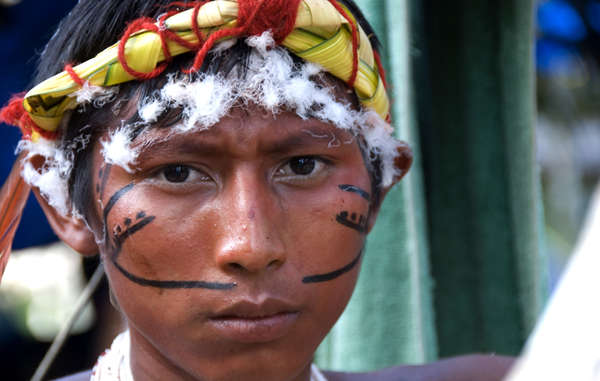
by Deep Green Resistance News Service | Mar 31, 2016 | Lobbying, Toxification
Featured Image: Gold miners have been invading Yanomami land for decades. © Fiona Watson/Survival International
Mercury poisoning is devastating tribal peoples across Amazonia, Survival International warned the U.N today.
In a letter to the U.N Special Rapporteur for Health, Survival International highlighted the failure of South American governments to address the contamination.
The unmonitored use of mercury, such as in illegal alluvial gold mining, often takes place on tribal peoples’ lands. Discriminatory attitudes towards tribal peoples mean that little action is taken to control it.
In Peru, 80% of a Nahua community have tested positive for high levels of mercury poisoning. 63% of those affected are children. Symptoms include anemia and renal failure, and one child has already died displaying symptoms consistent with mercury poisoning.
The Peruvian government has known about the mercury contamination since 2014 but has done little to identify the source. It is possible that other tribal peoples in the area have been affected, including uncontacted peoples.
In Brazil, new statistics reveal alarming rates of mercury poisoning amongst the Yanomami and Yekuana. 90% of Indians in one community are severely affected.
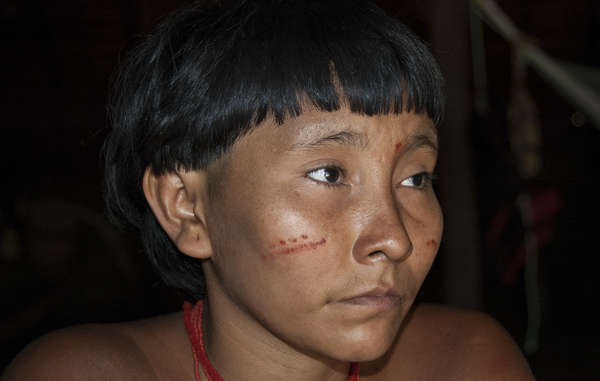
Without medical attention, mercury posioning can be lethal. Children and women of child-bearing age are most vulnerable
© Fiona Watson/Survival
Illegal gold miners operate on Yanomami land, polluting the rivers and forest with mercury. Uncontacted Yanomami are particularly in danger as many miners work near where they live.
Indigenous spokesman Reinaldo Rocha Yekuana said: “We are worried about the results of this research. This pollution affects plants, animals, and future generations.”
The Brazilian authorities have known about the mercury contamination since at least the 1980s, yet have failed to put a permanent stop to the illegal gold mining. Little has also been done to treat the affected Indians.
In Venezuela, several tribes including the Yekuana, Yanomami, Piaroa, Hoti and Pemon are also being devastated. 92% of Yekuana women in one region have levels of contamination far exceeding accepted limits.
Survival’s Director, Stephen Corry said: “These governments are sitting on a ticking time bomb. Every week that they fail to act, more and more indigenous peoples are being harmed. When mercury poisoning is identified, the source must be halted immediately and those affected must be treated. The effects will be catastrophic if indigenous peoples’ lands aren’t protected.”


















